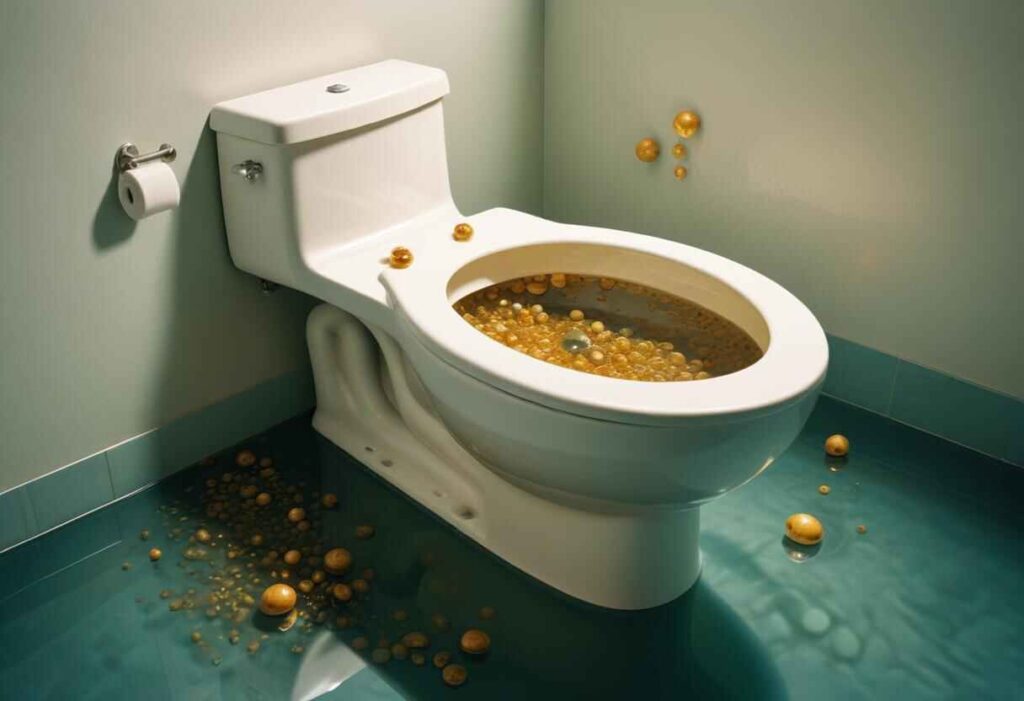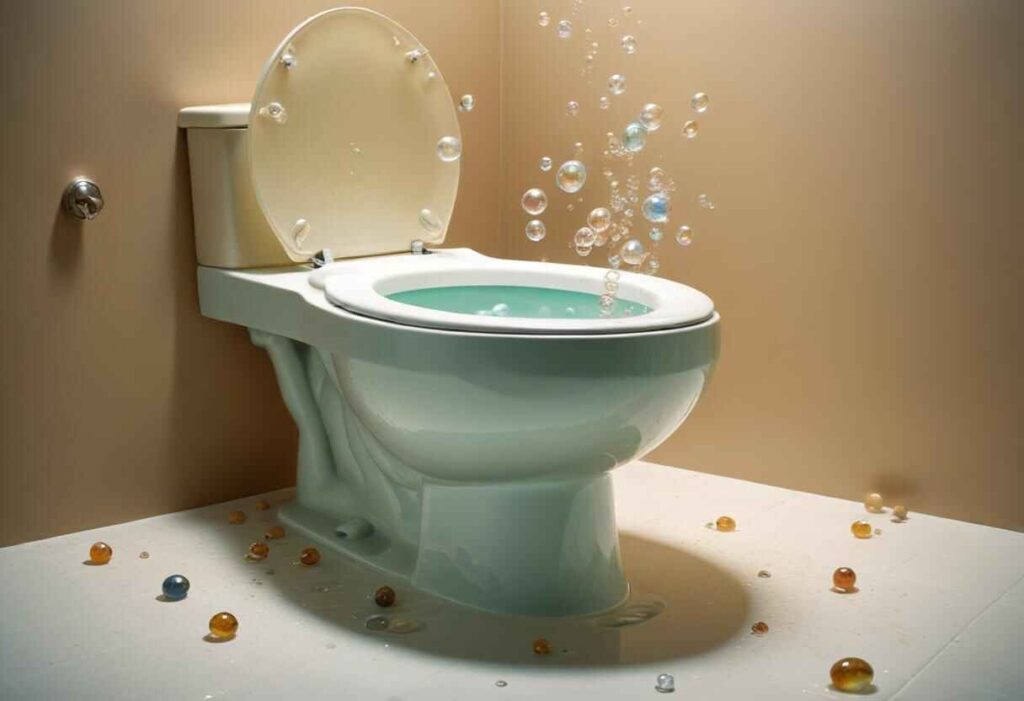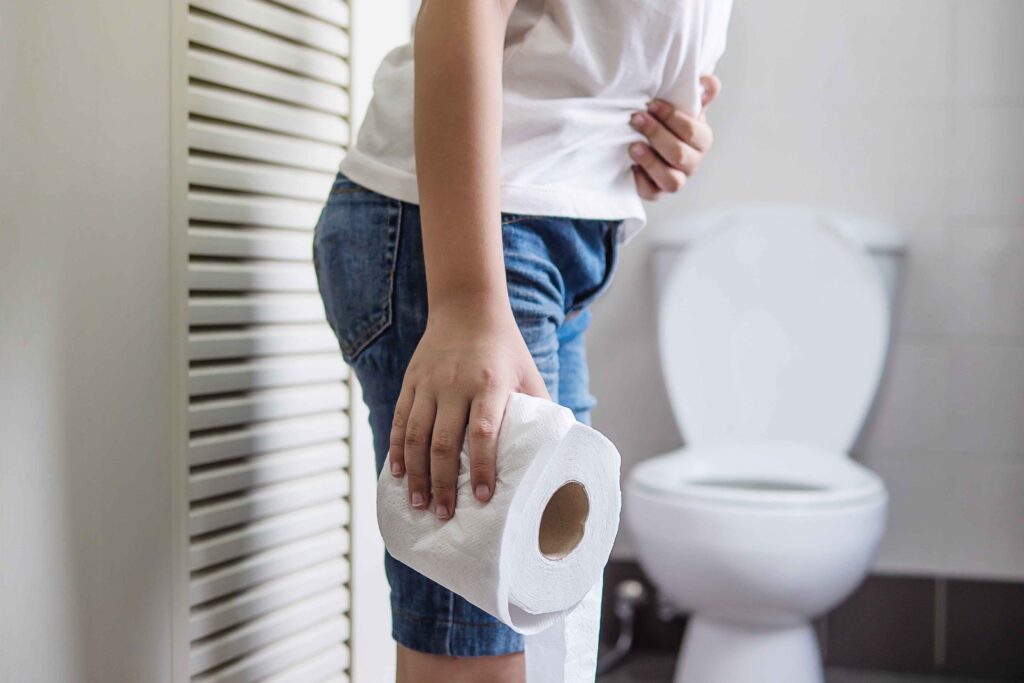Gallstones are hard bits that form in the gallbladder, a small part near the liver. They can be as tiny as sand grains or as big as golf balls. They might not always bother you, but they can hurt a lot sometimes. Sometimes, you might even see them in the toilet after you poop. What Do Gallstones Look Like in the Toilet? They can look like small, hard, yellowish or greenish balls, kind of like tiny rocks or clumps of sand.
What Are Gallstones?
Gallstones are mostly made of cholesterol or bilirubin. There are two main types:
- Cholesterol stones: These form when there’s too much cholesterol in the bile, or there isn’t enough bile salts to break it down.
- Pigment stones: These develop when there’s a high level of bilirubin in the bile, which can happen because of liver disease or blood problems.
Gallstones come in different sizes, shapes, and colors:
- Size: They can be super tiny or a few centimeters wide. Small ones might not bother you much.
- Shape: They may have flat sides, be oval or spherical in shape.
- Color: Cholesterol stones are usually yellow-green or brown, while pigment stones are often brown or black.
| Characteristic | Description |
| Color | Yellow-green, brownish, sometimes black |
| Size | Ranges from tiny sand-like grains to larger pebbles |
| Shape | Irregular, often oval or round, with rough or smooth edges |
| Texture | Hard and solid, may have a slightly gritty feel |
| Appearance in Water | May sink or float, depending on composition |
| Quantity | Can be a single stone or multiple stones; number varies per individual |
| Smell | No distinct smell, may be masked by other waste in the toilet |
| Detection | Often difficult to spot unless inspecting closely; can be mistaken for other debris |
| Presence of Bile | May be surrounded by bile, giving a greenish-yellow tint to the water |

What Do Gallstones Look Like in the Toilet
Gallstones are hard pieces that form in the gallbladder, a small sac near the liver. They range in size from small to golf ball-sized. Usually, you can’t see them when you pee. But if you do, they might look like small, bumpy pebbles, yellowish or brownish.
It’s important to know that passing gallstones can hurt a lot and cause symptoms like feeling sick, throwing up, and having pain in your upper belly. If you have any of these signs, it’s important to see a doctor for help.
Here are some more facts about gallstones:
- They happen more often in women than in men.
- They’re also more common in people who are overweight or obese, have family members with gallstones, or have diabetes.
- Usually, the treatment is surgery to take out the gallbladder.
| Related: Floating Gallstones in Toilet |
What Does it Mean if You Find Gallstones in Your Stool?
Discovering gallstones in your stool doesn’t always indicate a problem. Many people have them without any symptoms or issues. However, if you’re having severe abdominal pain, nausea, vomiting, or jaundice (yellowing of the skin and eyes), it could signal a more serious problem like a blocked bile duct or inflammation of the gallbladder. In such cases, it’s essential to seek medical attention.
| Aspect | Explanation |
| Possible Cause | Gallstones may pass from the gallbladder into the intestines, where they are excreted in stool. |
| Related Condition | Indicates the possible presence of gallbladder disease or bile duct obstruction. |
| Symptoms to Monitor | Abdominal pain, nausea, vomiting, jaundice, or changes in stool color (e.g., pale or clay-colored) |
| Medical Urgency | Should prompt medical consultation to evaluate underlying conditions and potential complications. |
| Associated Risk | Could indicate a risk of pancreatitis or bile duct inflammation if stones cause blockage. |
| Diagnostic Follow-up | Ultrasound or CT scan may be recommended to check for remaining stones or gallbladder issues. |
| Treatment Implications | May require treatment such as medication, dietary changes, or surgery if stones are symptomatic. |
| Long-term Management | Ongoing monitoring may be needed to prevent recurrence and manage gallbladder health. |
| Dietary Considerations | A low-fat diet may be advised to reduce the risk of further gallstone formation. |
| Complications | Risk of serious complications like gallbladder inflammation (cholecystitis) or bile duct infection (cholangitis). |
Causes of Gallstones
Gallstones can develop due to a number of reasons, such as:
- Excess cholesterol in bile: When there’s too much cholesterol in bile, it can lead to the formation of cholesterol stones.
- Excess bilirubin in bile: High levels of bilirubin can cause the formation of bilirubin stones.
- Slowed or blocked bile flow: Factors like obesity, rapid weight loss, or pregnancy can slow down or block the flow of bile, contributing to gallstone formation.
- Genetics: Some people may inherit a tendency to develop gallstones.
- Medical conditions: Conditions such as liver disease or diabetes can increase the risk of gallstones.
Symptoms of Gallstones
Gallstones don’t always cause problems and you might not even notice them. But when they block the bile ducts or cause inflammation, they can give you these symptoms:
- Strong belly pain, called biliary colic, that can last for hours.
- Pain in your back between your shoulder blades.
- Feeling sick and throwing up.
- Trouble digesting food and feeling bloated.
- Jaundice, which makes your skin and eyes turn yellow.
- Pale stools and dark pee.

Treatment Options for Gallstones
The treatment for gallstones depends on how bad the symptoms are and if there’s a risk of complications. Here are the options:
- Medications: Your doctor might give you bile acid pills to try to dissolve cholesterol gallstones. This works better for small stones, but it can take a long time to work.
- Laparoscopic Cholecystectomy: This is a surgery to take out the gallbladder. It’s done with small cuts in your belly and is the most common treatment for gallstones that cause problems.
- Endoscopic Retrograde Cholangiopancreatography (ERCP): This is a procedure that uses a special tool to remove gallstones from the bile ducts. It’s used when stones have moved from the gallbladder and are blocking the ducts.
Conclusion
In conclusion, gallstones are tiny, tough bits that can develop in your gallbladder. They can be yellow or brown and vary in size from tiny to as big as a golf ball. Sometimes, you might see them in your poop when they come out of your body. If you think you have gallstones, it’s crucial to see a doctor to figure out what to do next. With the right diagnosis and treatment, most people with gallstones can get better fully and avoid problems.

